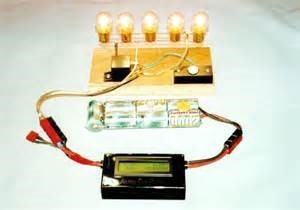Batteries are very easily overlooked and have been the culprit of many a mishap.
I was looking for some good common sense information about the care and handling of NiCD battery packs since I promised to cover this issue in my previous blog. In my efforts I came across this NASA NiCD battery care document and found it to be very interesting reading. It is full of the do and dont’s of storing cycling them.
“Storage of NiCd Batteries
Guideline No. 2 Flight batteries should be maintained in a discharged and shorted condition and stored at cold temperatures when not required for “critical” spacecraft testing. Optimal temperature is around 0 degrees C. NASA does it this way:
- Discharge at C/2 constant current rate to first cell at 1.0 Volts
- Drain each cell with a 1 ohm resistor to less than 0.03V
- Short each cell with a bar
- Place batteries in a sealed bag with dessicant (stops condensation)
- Store in cold temperature (about 0 deg C)
To re-charge such a stored battery Guideline No. 7 A battery stored discharged and shorted for a period greater than 14 days should be activated with a “conditioning cycle” prior to placing it in use. The conditioning cycle (20 deg C) is defined as follows:
- Remove from cold and allow to come to room temperature
- Charge at C/20 for 40 hours +/- 4 hours (Deliberate over-charge)
- C/2 discharge until first cell reaches 1.0V
- Drain each cell with a 1 ohm resistor to less than 0.03V
- Short each cell with a bar for 4 hours
- C/10 charge for 16 hours +/- 1 hour
- Do steps 3 and 4 again
- C/10 charge for 16 hours again ***
*** Steps 4,5,7 and 8 are not needed if the batteries haven’t been stored for an extended period of time. See note in Guideline 9 below.
What does this mean? Well it means that to store our packs we should use the lightbulb style (or similar) method to discharge our cells down to .9V per cell. Then we should use a discharge tray to bring them down to 0V per cell and then short them and store them in the freezer in a baggie with a dessicant. Then bring ’em up before we race with ’em if we want our packs to be in peak condition. Quite a process huh?
The “Memory” issue of NiCd Batteries
We have all heard of experiences similar to this one:
As for memory in ni-cads, it was described to me as follows re-charging a cell that is only partially discharged say 50% often enough will cause the battery to only accept a 50% charge. If you then discharge more than 50% say down to 25% the best a re-charge would get you would be 75% (25 + 50). After reviewing how my early camcorder batts died an early death this theory holds a lot of weight with me.
Unfortunately this conclusion is not entirely true. The real reason for his NiCd early death was probably over-charging. Most chargers that come with equipment that use NiCd batteries aren’t very sophisticated and over-charging is very easy to do. This is why the manuals tell you to fully discharge your NiCds packs before charging, their chargers aren’t peak detecting and the only way to “know” that a pack is properly charged is to drain it first. The reason that our NiCds lose their capacity are manifold and complex but usually come down to voltage depression and crystal formation on the electrodes. The former is caused by age and over-charging and the latter usually by low discharge rates.
The most common problem is the formation of large crystals on the electrodes, this shows up to us as a “soft” pack, that gets better each time you run it on race day. According to one paper, this is caused by trickle charging, according to this NASA publication it is caused by low level discharging (leaving the battery sit open circuit or under light load). High discharge rates tend to bust up large crystals though, so that is a good thing for us.
To avoid this low level discharge we should reduce the charge of our batteries as much as is feasible before storage. The procedure above details this process in far more detail than any of us would probably care to take. But it does give us pointers to way to keep our cells in good condition within the level we each choose to afford.
Voltage depression usually occurs because of overcharging. Fortunately, this condition can usually be overcome by a few discharge/recharge cycles. I got this tidbit of information from an article the Navy published on reconditioning its massive supplies of NiCd packs and the money they saved by doing it. Unfortunately, I can’t find that article any more so I can’t quote much from it.
Other Useful NASA Guidelines for NiCds
Here are some useful bits of info in the form of other guidelines from NASA:
Guideline No. 3
The use of flight batteries after an open circuit stand of 4 hours or longer should be initiated with a short (3 to 5 minutes) discharge prior to initiating battery charge. Using a normal load.
Guideline No. 4
During short periods when the battery is not needed to support spacecraft integration and test, it should be maintained on a low rate trickle charge. Low rate is defined as C/60 to C/100.
Guideline No. 8
Batteries should not stand on open circuit for more than 7 days without being charged. Charging should be initiated only after implementing Guideline No. 3.
And finally, this is a useful guideline for us racers:
Guideline No. 9
A battery should be “reconditioned” if it has been on open circuit, subjected to intermittent use, i.e, open circuit, trickle charge, occasional discharge, etc., for a period of 30 days. Reconditioning is effected by performing the following sequence at 20 deg C:
- discharge at C/2 constant current rate to first cell at 1.0V
- Drain each cell with 1 ohm resistor to less than 0.03V
- Short each cell for a minimum of 4 hours
- Recharge battery at C/20 constant current rate for 40 hours +/- 4 hours (see NOTE below)
NOTE: The re-charge method following step 2 is not critical if the cells have not been discharged and shorted for extended periods. After a few hours (4-8) at the C/20 rate, charging at high rates is acceptable. If the battery is integrated into the spacecraft, final charging can be accomplished with the spacecraft battery charger.
”
NASA Reference Publication 1326, February 1994 Handbook for Handling and Storage of Nickel-Cadmium Batteries: Lessons Learned by Floyd E. Ford Swales & Associates, Beltsville, Maryland) and Gopalakrishna M. Rao, Thomas Y. Yi (Goddard Space Flight Center, Greenbelt, Maryland) Published by NASA Scientific and Technical Information Branch.
Now The way that I have found through the years:
I have always stored them with a full charge and am certain to cycle them at least once if I have left them set for a week or two. After a month or more I will cycle them a couple of times to both ensure that I see a steady discharge time and to also help rejuvenate them. I have several packs that are over 5 years old and although I would never fly with them I still cycle them from time to time just “to see” if they are actually still in working order out of curiosity.
NiCD batteries are easy to cycle even if you do not have a battery cycler. (which is recommended) I have a 4.8 volt 75 ma light bulb that I have connected a battery charger lead to. I know that on a full charge my 400 ma pack should light the bulb for around 5 hours.
I know this because: Time = battery capacity/battery discharge Time = 400/75 Time = 5.3333
Like I said though, a cycler is the best way to properly cycle battery packs. The light bulb method is very “old school” and will only work, as far as I know, on NiCD and NiMH battery packs.
I will cover the differences and similarities between the two very soon.
Keep your batteries serviced and do not let them be the reason for losing control of your aircraft.
Enjoy the weather and happy flying until next time!
Bradford Booth


